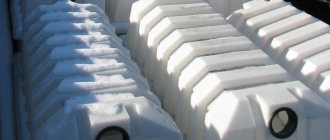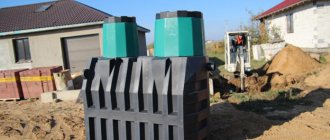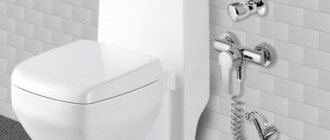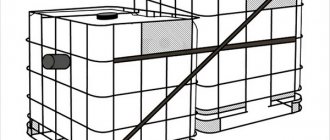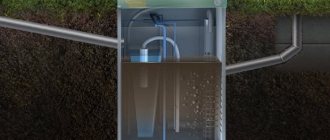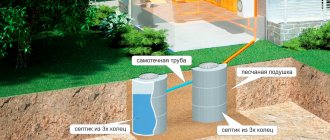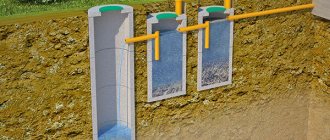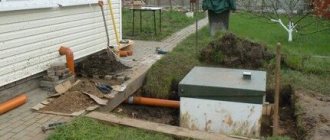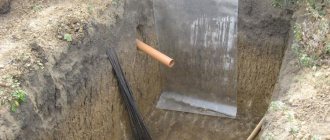People living in villages with country houses, cottages and dachas are faced with the problem of draining wastewater and waste products. In such places, as a rule, there is no centralized sewerage system, so an alternative is to use an autonomous treatment plant. The Termite septic tank acts in this capacity. With its help, wastewater is purified to such an extent that purified water can be used for technical needs and irrigation. Below we will look at what features the Termit septic tank has - installation, connection and operation of the drain purifier.
How the Termite septic tank works and works
The purpose of a septic tank is to purify the wastewater entering it using sedimentation methods, decomposition of organic waste by microorganisms, and subsequent filtration.
Device
The Termite septic tank consists of the following elements:
- The body is made of durable plastic, 1.5-2 cm thick. It is divided inside into 2 or 3 chambers. Models of the Transformer series consist of 4 cameras.
- On top of the body there are 1 or 2 hatches through which the purifier is serviced.
The building contains:
- Storage tank. Wastewater flows into it.
- Bacterial treatment chamber.
- Filter element.
Termite septic tank installation
The principle of operation of the Termit septic tank
All wastewater coming from sinks, toilets, dishwashers and washing machines is sent to the first section of the septic tank. In it, the liquid settles with solid particles falling to the bottom. At the same time, a film of fat forms on the surface of the liquid. When the liquid level reaches a certain level, it flows through the pipe into the second chamber. The pipe is designed so that sediment and grease film do not flow into the next chamber.
In the second chamber, the liquid re-settles with sediment falling to the bottom. After such two settlings, the liquid already receives a certain degree of purity. Some septic tank models may not have a second chamber.
Through the overflow pipe, the liquid is directed to the next section, which contains anaerobic microorganisms. They decompose organic matter remaining in the water, resulting in the formation of sludge at the bottom of the container, and the resulting gas comes to the surface.
Water treated with microorganisms rises up and passes through a pumice filter. After filtration, it acquires a purification degree of about 70-85%. After this, the purified water enters the infiltrator (irrigation field dome), drainage well or filtration fields. As a result of such additional soil filtration, the degree of water purification reaches about 95%.
Septic tanks with soil post-treatment from RUB 30,500
| Up to 3 people Daily processing up to 600 l Bars, Chistok, Tank, Flotenk, etc. from 30,500 R | Up to 5 people Daily processing up to 1000 l Bars, Chistok, Tank, Flotenk, etc. from 51,300 R | Up to 8 people Daily processing up to 1500 l Bars, Chistok, Tank, Flotenk, etc. from 64,800 R | Up to 10 people Daily processing up to 2000 l Bars, Chistok, Tank, Flotenk, etc. from 75,700 RUR |
Advantages and disadvantages of a septic tank
Let us first list the advantages of the device in order to understand why the Termite septic tank has mostly positive reviews:
- There is a choice of several dozen models from which you can choose the appropriate option for your conditions;
- The degree of wastewater treatment when using an infiltrator or drainage well is up to 95%;
- Simple installation of the Termite septic tank - its installation does not require concreting or other types of fastening. It is enough to place the unit in the pit and connect it to communications, backfill it and you can start using the septic tank;
- The septic tank does not require an electrical connection to operate;
- The body has a high level of strength, which allows it to withstand soil pressure without problems;
- Reasonable cost;
- Durability. All elements of the septic tank can serve for at least 50 years without repair or other external intervention;
- The absence of seams makes the device airtight, so any leakage of purified water is excluded;
- The operation of the septic tank does not stop even with significant fluctuations in temperature, groundwater level and atmospheric pressure.
The Termite septic tank is a worthy alternative to the Tank septic tank
. Despite the many advantages, the Termite septic tank also has several disadvantages:
- The device does not have special filters to clean the exhaust air. This leads to the release of unpleasant odors;
- There is no deep cleaning system;
- Installing a septic tank in the ground requires excavation work to prepare the pit;
- The corners of the plastic body of the septic tank are not rounded, so there is a risk of increased stress on them. As a result, the walls of the housing may bend;
- Once every 2-3 years it is necessary to clean the first compartment;
- Users note the uneven thickness of the case walls (from 1 to 2 cm).
Owner reviews
I ordered Termite for my summer cottage, designed for 2m³. I installed the structure together with a friend, and I had to order special equipment, because it turned out to be unrealistic to load the septic tank on my own. Connecting and installing all communications did not cause any difficulties.
Igor, Kazan
It took us a long time to choose a septic tank. As a result, we purchased Termite for 5.5 m³. Volume was the deciding factor. In addition, the compact shape and significant wall thickness were captivating. I am very pleased with this septic tank .
Sergey, Barnaul
I took a Termite septic tank for my dacha. I installed it together with my husband. Installation is quite simple; moreover, instructions are included with the equipment. The device has been working for six months already. It does not clog and cleans drains perfectly. I added bacteria only once in the spring and will add it again in six months.
Elena, Pskov
Among all the septic tanks on sale, special attention should be paid to the Termite design. Its advantages are energy independence and affordable price. You can install the structure yourself, which is an additional advantage of the equipment.
Types and characteristics
The range of Termite septic tanks includes 3 lines of devices: Pro, Standard and Transformer.
Series "Standard"
The “Standard” line of septic tanks is made of linear polyethylene. The thickness of the chamber walls for all products is up to 15 mm. If you buy a Termite septic tank for a summer residence, then the “Standard 2.0” model ideally suits the living conditions of 3-4 people due to its small size and low productivity. But the “Standard 5.5” model is better suited for small cafes and mini-hotels. The “Standard 2.0” model has 2 cameras. The remaining models are three-chamber.
The hatch necks have diameters of 50 and 65 cm.
Septic tanks of the “Standard” line
| Options | Standard 2.0 | Standard 3.0 | Standard 3.5 | Standard 5.5 |
| Overall volume | 2000 l | 3000 l | 3500 l | 5500 l |
| Performance | 700 l/day | 1200 l/day | 1400 l/day | 2200 l/day |
| Number of persons | 4 | 6 | 7 | 12 |
| Dimensions | 1595 x 1155 x 2005 mm | 2390 x 1155 x 1905 mm | 2410 x 1190 x 2005 mm | 2220 x 1650 x 2395 mm |
| Number of necks | 1 | 2 | 2 | 2 |
| Septic tank weight | 105 kg | 135 kg | 175 kg | 215 kg |
Series "Pro"
Septic tanks of the “Pro” line are made from linear polyethylene. The products are characterized by increased chamber wall thickness - up to 20 mm. Accordingly, the strength of such devices is also increased. Models with a total volume of up to 2.5 liters inclusive have 2 chambers. Starting with the “Profi 3.0” model, septic tanks are equipped with three-chamber tanks. For a small summer cottage, it is recommended to choose the “Profi 1.2” model, intended for houses with an area of up to 100 square meters. And the “Profi 2.0” model is suitable for a house with an area of up to 200 square meters. More productive options are selected depending on the number of people living in the house.
Septic tanks of the “Pro” line
| Options | Pro 1.2 | Pro 2.0 | Pro 2.5 | Pro 3.0 | Pro 3.5 | Pro 5.5 |
| Overall volume | 1200 l | 2000 l | 2500 l | 3000 l | 3500 l | 5500 l |
| Performance | 400 l/day | 800 l/day | 1000 l/day | 1200 l/day | 1800 l/day | 2200 l/day |
| Number of persons | 2 | 4 | 5 | 6 | 7 | 12 |
| Dimensions | 1340 x 1160 x 1565 mm | 1595 x 1155 x 2005 mm | 2000 x 1155 x 2005 mm | 2390 x 1155 x 1905 mm | 2410 x 1190 x 2005 mm | 2220 x 1650 x 2395 mm |
| Number of necks | 1 | 1 | 2 | 2 | 2 | 2 |
| Septic tank weight | 80 kg | 115 kg | 135 kg | 165 kg | 185 kg | 265 kg |
Transformer series
Septic tank Termit transformer of all modifications is made of linear high-density polyethylene. The septic tank is solid. Inside the body there is a cast bulb, which gives the septic tank additional rigidity, preventing deformation of the walls. All models in this series have 4 cameras. This is what distinguishes them from other lines.
Septic tanks "Transformer" have letter indices:
- "S" - gravity cleaning system.
- "PR" - forced cleaning system. The septic tank kit includes a drainage pump. Purified water is collected in the 4th chamber, from where it is forcibly pumped out by a pump.
"Transformer S" is non-volatile. The Transformer PR model is partially volatile. Requires power to operate the sump pump.
Septic tanks of the “Transformer” line
| Options | 1.5 | 2.0 | 2.5 | 3.0 |
| Overall volume | 1500 l | 2000 l | 2500 l | 3000 l |
| Productivity (l/day) | 600 | 800 | 1000 | 1200 |
| Number of persons | 3 | 4 | 5 | 6 |
| Dimensions | 2000 x 800 x 2000 mm | 2000 x 1000 x 2100 mm | 2050 x 1050 x 2110 mm | 2190 x 1200 x 2070 mm |
| Number of necks | 1 | 1 | 1 | 1 |
| Septic tank weight | 110 kg | 130 kg | 145 kg | 170 kg |
Advice: Choose the volume of the septic tank based on the number of people who will live permanently or temporarily in the house. You should not overpay for volume that will not be in demand.
Deep cleaning nets from 58,900 RUR
| Up to 3 people Daily processing up to 600 l Max. from 58,900 RUR | Up to 5 people Daily processing up to 1000 l Max. from 71,200 RUR | Up to 8 people Daily processing up to 1500 l Max. from 89,500 R | Up to 10 people Daily processing up to 2000 l Max. from 107,900 R |
Installation features for different soils
Installation of a Termit septic tank can be done in various ways, depending on the type of soil on the site:
Soil with normal water absorption
In this case, a system of drainage pipes is connected to the outlet of the Termit septic tank, through which water is absorbed into the soil. An irrigation dome can also be used. Its capacity depends on the performance of the septic tank.
Septic tank Termite with irrigation dome
Sandy soil
This soil absorbs moisture well, so any type of drainage is suitable. If the groundwater in the area is deep, more than 1.5 m, then a drainage well can be installed at the outlet of the purifier.
Septic tank Termite with drainage well
High groundwater level
If the groundwater level is high, an intermediate drainage well is used with the connection of a drainage pump and a check valve. Water from the well is pumped into an irrigation dome or onto the ground surface.
Constantly high groundwater levels
A drainage well is used, from which water is pumped into the irrigation dome. The dome is placed on the surface of the ground and additionally insulated with an earthen layer.
Installation of a septic tank with a high groundwater level
Clay soil
After the septic tank, a filtration field is constructed, consisting of several layers of crushed stone and sand. The water first passes through the filtration field and then enters the drainage well. From there it goes into the ground or is taken for household needs.
Models
There is a wide range of Termit cleaning mechanisms, which differ in performance and design dimensions.
Drives
These are sealed containers designed to collect household waste. This type of installation offers the simplest installation and operating principle. Let's look at the types of drives that are available in 6 modifications.
"Termite 2F"
The reservoir of the device consists of 2 chambers, the productivity of which is 700 l/24 hours. The Termit septic tank is designed to serve 2-4 residents. This septic tank has 1 neck, which is used to pump out sludge from the bottom of the container. The system is equipped with 2 fittings, the diameter of one fitting is 11 cm. The weight of the structure is 140 kg, the volume of the container is 2 cubic meters. l. A load of pumicite and a weighting agent is placed in the filter mechanism. The dimensions of the septic tank are 1415x1155x2005 mm.
"Termite 2.5F"
The capacity of the container is 2500 liters, it has 2 chambers, and is designed to serve 3-5 people. Each chamber of the cleaning mechanism is equipped with a neck. The diameter of 1 compartment is 50 cm, through which the sludge is pumped. 2 chamber with a diameter of 65 cm, which is used for special filter maintenance. The productivity of the structure is 1 m3/24 hours. The thickness of the case walls is 20 mm, dimensions are 1820x1155x2005 mm. The weight of the system without a filter mechanism is 120 kg.
"Termite 3F"
Capacious mechanism, the volume of which is 3000 liters. The productivity of the system is 1.4 m3/24 hours, the septic tank can serve 4-6 residents. This type of septic tank consists of 3 chambers, which affects the quality of wastewater treatment. The dimensions of the mechanism are 2210x1155x1905 mm.
"Termite 3.5F"
The three-chamber cleaning mechanism with built-in filter mechanism has a rectangular shape and is equipped with 2 necks with opening lids. The tank volume is 3500 liters, productivity is 1.8 m3/day. This capacity of the tank allows serving 5-7 people. Case dimensions – 2230x1190x2005 mm, structure weight – 175 kg (without filter).
"Termite 5.5F"
The most capacious purification system among the Termit septic tank models, because the tank volume is 5500 liters and the productivity is 2.5 m3/24 hours. A powerful cleaning mechanism is capable of cleaning wastewater from several baths, toilets, and washing machines. It is manufactured to serve 7-11 residents. Capacity parameters: 2220x1650x2395 mm, system weight – 260 kg.
"Termite Pro"
The Termit Pro septic tank is a non-volatile installation structure. It is designed to serve seasonal dacha residents. The disadvantage of installing this design is that the septic tank can operate at low groundwater levels. manufactures such installations in 5 modifications. The lowest-power mechanism is the Termit Profi 1.2, whose productivity is 400 l/24 hours, and can be operated by 1-2 people.
"Transformer S"
This is a series of installations with gravity drainage. The inside of the tank consists of 3 compartments. The overflow from compartment 1 to compartment 2 is equipped with a large-fraction filter mechanism. The second chamber is filled with a polymer filler to create comfortable conditions for the functioning of microorganisms. From chamber 3, the liquid flows by gravity into the sprinkler for soil purification.
"Transformer PR"
The internal arrangement of such units is similar to the treatment facilities of the previous series. They differ only in that the “Transformer PR” model provides for the installation of a drainage pump to pump liquid from chamber 3 to the filtration fields. The pipes of this septic tank have different diameters - 11 cm and 32 cm. The most popular model among users is “Transformer 2”, which can serve 3-4 people, and the productivity of the tank is 800 l/24 hours.
How to install a Termite septic tank yourself
Below are instructions for installing a Termite septic tank on your own plot of land.
Important: The location of the septic tank must comply with the requirements of regulatory documents. The distance from the septic tank to other objects should be maintained as follows: to trees - 3 m, to a house - 5 m, to a neighboring plot - 2 m, to a road - 5 m, to an open reservoir - 30 m.
The work is performed in the following order:
1. A pit of the required size is dug. The dimensions of the pit should be 20-30 cm larger than the dimensions of the septic tank, and its depth should be 10 cm greater than the height of the septic tank.
2. The bottom and walls of the pit are leveled, removing earth and stones.
3. A layer of sand about 10 cm thick is poured onto the bottom of the pit.
4. This is followed by laying geotextiles on the bottom and walls of a separate pit for the irrigation dome (if any) and backfilling it with gravel about 40 cm thick.
5. A trench is dug for laying the sewerage supply pipes. It should have a slope of 2 cm for every 1 m of length. The bottom of the trench is also covered with sand about 30 cm thick.
6. A septic tank is installed in a dug pit.
7. Sewer pipes are laid and connected to the inlet of the septic tank.
Connecting pipes to the septic tank
8. The septic tank and supply trench are filled with sand. The sand should cover the body to the top. It is possible to backfill the pit with a mixture of sand and cement in a ratio of 5 to 1.
9. Simultaneously with backfilling the septic tank, it is necessary to fill it with water for better shrinkage and protection of the walls from compression by soil. The water filling level should be 20-30 cm ahead of the backfill level.
10. The mixture to be filled is compacted every 25 cm. Backfilling is done to the level of the inlet and outlet pipes. Backfilling is done manually, as this allows you to get a better result.
Installation of a Termite septic tank in a pit and backfilling it
11. A trench is dug for the outlet pipe. A drainage pipe is laid in it with a slope of 1-2 cm per 1 meter of length. An irrigation dome can also be connected to the pit as a filter element. If only perforated drainage pipe is used, it should be wrapped with geotextile to prevent clogging of the holes.
12. The filter element or drainage pipe is connected to the outlet of the septic tank using a discharge pipe. The connection point is sealed.
13. At the end of the irrigation field, an exhaust riser is installed, which prevents the occurrence of air locks when discharging water from the septic tank.
14. The pit and trenches are completely covered with soil.
Final filling of the septic tank
In order for the Termite septic tank to serve for a long time and without failure, it is necessary to provide it with proper care. To do this, sludge and solid particles should be pumped out of the chambers every 2-3 years. It is also recommended to use biological products specifically designed for the decomposition of wastewater.
Autonomous sewerage - it's easy!
Are you looking for a good price on a particular septic tank? Or do you need a turnkey septic tank installation
? Or maybe you are looking for a decent level of service? You've come to the right place! I’m ready to answer any of these questions and more. Having many years of experience in the field of engineering systems, our company guarantees you the highest level of service, affordable prices for the most popular models of septic tanks and completion of all work on installation, installation and commissioning of the system within one day! All you have to do is leave a request on the website or call the number provided.
